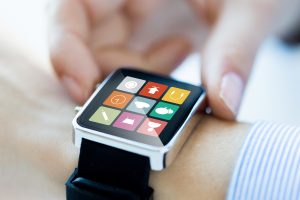Wearable technologies have transformed greatly in the past decade, especially when it comes to how it is used in the healthcare industry. The term “wearable” is thrown around a lot.  It can be applied to anything from analog wristwatches, to those 80’s calculators that can be worn on your wrist, but now it resides on the Fitbit, Apple Watch, and other tech-infused personal products.
 Now, when someone refers to “wearables” they are often referring to digital pieces of technology that can be worn and are able to connect to the internet, enabling data to be exchanged between a network and the device. This ability to both send and receive data has pushed wearable technology to the forefront of the Internet of Things space (IoT). Technology that started as simple pedometers, enabling users to track the amount of steps they took daily, has transformed both in the scope of things they can monitor as well as the sophistication of networks in which they transmit and share data.
Now, when someone refers to “wearables” they are often referring to digital pieces of technology that can be worn and are able to connect to the internet, enabling data to be exchanged between a network and the device. This ability to both send and receive data has pushed wearable technology to the forefront of the Internet of Things space (IoT). Technology that started as simple pedometers, enabling users to track the amount of steps they took daily, has transformed both in the scope of things they can monitor as well as the sophistication of networks in which they transmit and share data.
Many hospitals and other healthcare professionals have begun using these devices to monitor patient health inside and out of the hospital. The most basic functions of these devices can now monitor and track daily steps, exercise levels, heart rate, and even sleep schedules. The next generation of Apple Watches will reportedly feature glucose monitoring for people with diabetes.
Doctors and nurses can now use wearables to constantly monitor a patient’s vitals inside and outside of the hospital to increase the validity of the data and provide a more holistic picture of a person’s health day over day. These devices can also keep track of patient’s data more accurately than self-reporting and can aid patients in adhering to a medical plan prescribed by their doctors. This will reduce the number of patients that end up being readmitted to the hospital for false alarms, not following an exercise plan, not taking medications, or ingesting the incorrect amount of medication just to name a few.
 One application of wearable technology many companies are beginning to explore is tracking the day-to-day health habits of individuals. While this sounds a bit “Big Brother-esque”, it can enable your company to provide lifestyle data in which they can leverage insurance companies into reducing healthcare premiums for their employees. Insurance companies benefit as well from these wearable devices as a means for increased the sources of fitness data. All of the collected information can be correlated with employee’s overall healthcare costs to create calculations of potential optimization, provide insights on how much to charge for insurance policies, and derive incentives to offer customers through usage of these devices.
One application of wearable technology many companies are beginning to explore is tracking the day-to-day health habits of individuals. While this sounds a bit “Big Brother-esque”, it can enable your company to provide lifestyle data in which they can leverage insurance companies into reducing healthcare premiums for their employees. Insurance companies benefit as well from these wearable devices as a means for increased the sources of fitness data. All of the collected information can be correlated with employee’s overall healthcare costs to create calculations of potential optimization, provide insights on how much to charge for insurance policies, and derive incentives to offer customers through usage of these devices.

This marks an ever growing trend in health and life insurance. Â Companies are taking a greater interest in improving the everyday health and longevity of their customers while reducing their expenses. Â When people think about the healthcare industry they often think about nurses, doctors and hospitals that provide patient care. However, both the patients and the insurance companies are integral to the form and function of the healthcare industry holistically.
 What is more surprising than companies wanting to track their employees’ healthcare data to lower insurance premiums, is the willingness of the employees to partake in these programs. Given the heightened concerns over data security and consumer privacy online, one would expect that employees would be wary of sharing Fitbit and Apple Watch data. However, most employees are viewing these programs positively because it keeps them accountable in accomplishing their personal health goals and rewards them with money-saving benefits.
What is more surprising than companies wanting to track their employees’ healthcare data to lower insurance premiums, is the willingness of the employees to partake in these programs. Given the heightened concerns over data security and consumer privacy online, one would expect that employees would be wary of sharing Fitbit and Apple Watch data. However, most employees are viewing these programs positively because it keeps them accountable in accomplishing their personal health goals and rewards them with money-saving benefits.
Wearable technology and the Healthcare industry are both areas that are undergoing continuous innovation to better the effectiveness of their own individual industries. Together these innovations will have far-reaching impacts on health-related industries and the daily life of its consumers.


